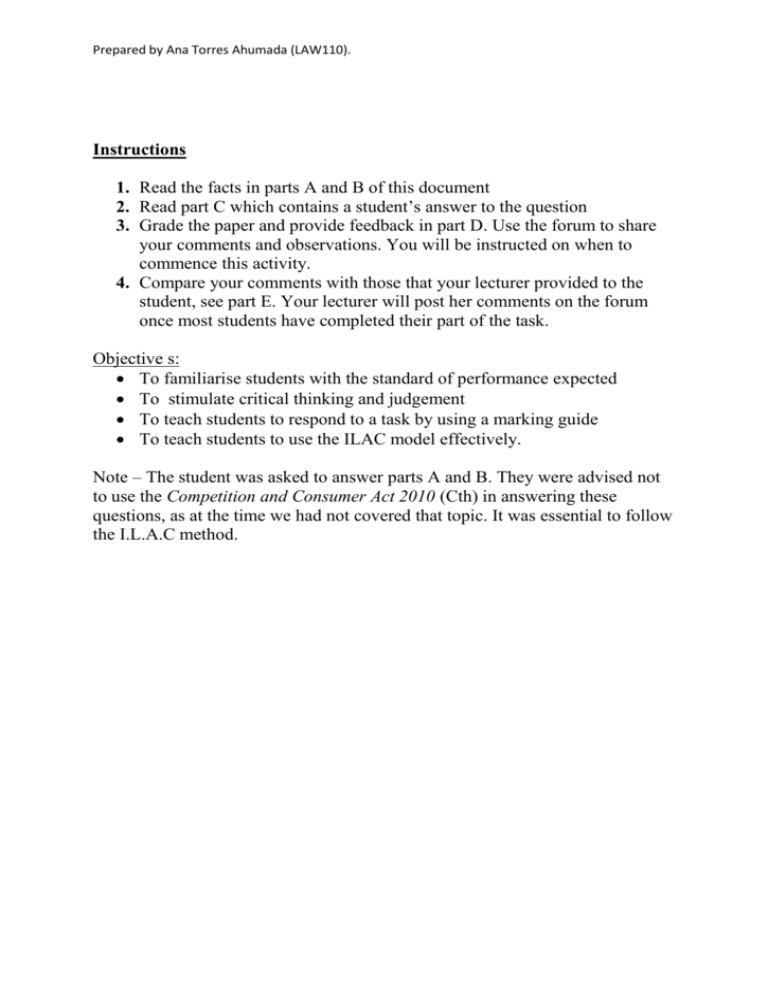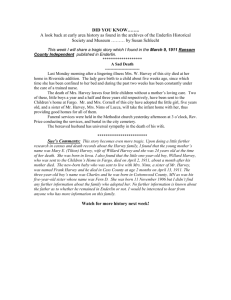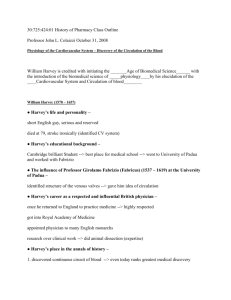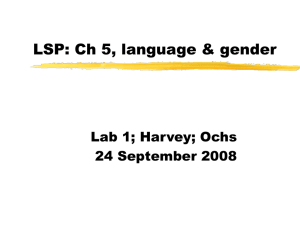Law Assignment Grading Activity
advertisement

Prepared by Ana Torres Ahumada (LAW110). Instructions 1. Read the facts in parts A and B of this document 2. Read part C which contains a student’s answer to the question 3. Grade the paper and provide feedback in part D. Use the forum to share your comments and observations. You will be instructed on when to commence this activity. 4. Compare your comments with those that your lecturer provided to the student, see part E. Your lecturer will post her comments on the forum once most students have completed their part of the task. Objective s: To familiarise students with the standard of performance expected To stimulate critical thinking and judgement To teach students to respond to a task by using a marking guide To teach students to use the ILAC model effectively. Note – The student was asked to answer parts A and B. They were advised not to use the Competition and Consumer Act 2010 (Cth) in answering these questions, as at the time we had not covered that topic. It was essential to follow the I.L.A.C method. Prepared by Ana Torres Ahumada (LAW110). Part A [15] Mr and Mrs Mendez are elderly and came to Australia as migrants from Colombia about 40 years ago. They are unfamiliar with written English and their spoken English is not very good. They have two sons; Franchesco ( 27) and Problemo ( 40). Their son Problemo, a property developer asks his parents to sign a guarantee and mortgage to the Usurer's Commercial Bank as security for payment of the debts of Problemo's company. At the time of signing Problemo led his parent to believe that the guarantee and mortgage were for up to $ 50 000 and limited to six months. Mr and Mrs Mendez went to the bank and saw one of the bank loan officers to sign the mortgage. When the loan officer tried to explain to the parents that the guarantee is unlimited in both amount and duration the parents became confused. The parents and the loan officer could not satisfactorily communicate, and the interview concluded by the loan officer stating: ‘It is up to you to decide whether to sign it.’ The loan officer did not explain to the couple the possible effect of the documents, which the Mendez could not read, and he made no mention of the fact that the amount was unlimited. Mr and Mrs Mendez who loved their son very much decided then to sign the mortgage, and eight months later their son’s business collapses with Problemo then owing $500,000 to the bank. Problemo's company went into liquidation and the bank is attempting to exercise its rights under the mortgage/guarantee. Advise Mr and Mrs Mendez of their rights. Part B [15 marks] Billy Their other son, Franchesco, is thinking of putting in a new air conditioning unit in his factory. He has been in negotiations with Freez It Aircon Ltd, owned by Fergie. One Monday morning he comes into his office and sees the latest draft contract from Freez It Aircon, with details of specifications of the air conditioners , price and installation date. The top sheet of the contract contains a space which says “I agree to these terms of supply” and with a space for a signature and date. Franchesco sets the contract aside on his desk, and it soon gets mixed up with piles of other paperwork. Later during the day, he signs the form, thinking that it was the front page of another contract he had been sent by a supplier of microchips. He gives it to his office manager, Tomah, and says “Send this by fax”. A few days later a truck from Freez It Airon arrives at Frank’s factory. Franchesco phones up Fergie and says he never agreed to the installation. When Fergie tells him about the fax, he realizes his mistake and tells her that he had sent it by accident. She says“Too bad, we have a deal – I have already spent several thousand dollars making customized components for your system”. Franchesco seeks your advice with this matter. Prepared by Ana Torres Ahumada (LAW110). Part C [Answer submitted by a student] Student’s attempt – Part A Identify legal issue The legal issue relevant to the Mendez case lies under contract law, and the “vitiating element of unconscionability” (Harvey Pg240). Given the Mendaz’s lack of English speaking and language skills and this presenting a “special disadvantage” (Harvey, Pg257) in signing the contract. The banks loan officer, who was aware of this disadvantage allowed them to sign resulting in an unfair situation for the Mendaz’s and an unconscionable act by the Usures commercial banks loan officer to allow them to sign. Therefore the legal issue of an unconscionable contract was created between the Mendaz and the bank Relevant law Relevant law includes; “common law” (Harvey, pg.259) “Competition and consumer act 2010” (Harvey, pg.259) “the fair trading act 1989 (QLD)” (Harvey, pg.259) “contracts review act 1980 (NSW)” (Harvey, pg.259) Legal principals Law relevant to unconscionable contracts are common law which “permits a contract to be deemed voidable if unconscionable conduct has taken place” (Harvey, pg.257) statute law also prohibits unconscionable conduct under “commonwealth level’ (Harvey, pg.257) under the “competition and consumer Act 2010 (cth)” (Harvey, pg.257) which protects “consumers from traders in relation to U.C in supply in goods and services (Section 51 Act” (Harvey, pg.258). State legislation “prohibits persons from engaging in unconscionably fair trading act (QLD)” (Harvey, pg.258) and in addition to this NSW has the “contracts review act 1980 (NSW)” (Harvey, pg.258) which allows the “supreme court of NSW to review unjust and unconscionable contracts” (Harvey, pg.258). The situations under this act relevant to the Mendaz case include “Where either party’s education, literacy, or economic status played a role in their decision to enter into the contract” (Harvey, pg.258). Prepared by Ana Torres Ahumada (LAW110). Common law Evidence needed under common law include: The weaker party had a disability or special disadvantage That the stronger party knew about their disability or special disadvantage and took advantage of this disability That the disability prevented them from making an independent decision about the contract. Of importance is that the “law recognizes disability or social disadvantage in the form of illiteracy, limited education and lack of access to legal advice” (Harvey, pg.257). Name of case and act citied “Commercial bank of Australia V Amado [1983] 151 CLR 447” (Harvey, pg.257) Applying law to the ACT Under common law the facts presented address the requirements of evidence to determine unconscionability. The Mendaz were the weaker party due to illiteracy and limited education in spoken English and therefore had a “disability or special disadvantage recognized by the law” (Harvey, pg.257). facts gives evidence to the “stronger party knowing about their disability” (Harvey, pg.257) which was evident by the Mendaz being confused and the interview concluding without the loan officer or the Mendaz being able to communicate satisfactorily, and lastly the disability which is relevant to this case in the form of “illiteracy and limited education” (Harvey, pg.257) prevented them from making an independent decision in signing the contract and their ability to give genuine consent. Therefore the facts under common law present evidence as an unconscionable contract existing between both parties. Conclusion Given the evidence requirements under common law and the facts of the Mendaz case it is likely that the contract will be “voidable at the option of the plaintiff” (Harvey, pg.258) if the case is to be found in favor of the Mendaz (plaintiff). (Harvey, pg.258) . Prepared by Ana Torres Ahumada (LAW110). Student’s attempt ( part B) Legal issue Franchesco has mistakenly signed a contract with FREEZE it Aircon and therefore entered into a valid contract due to franchescos mistake and not wanting to keep to the agreement he mistakenly signed legal issues arise in relation to the making of a valid contract and whether Franchesco did this but also the valadility of the contract due to his mistake Name of case and Act citied The case citied is (Petelin v Cullen [1975] 132 CLR 355) Apply the law In order to establish the valadility of the contract the three legal principals of agreement, intention to create legal principals of agreement, intention to create legal relations and considerations must be satisfied. Agreement took place during negotiation of the contract which was then signed (acceptance) by Franchesco signaling an agreement exists. Signing also “expressed intention” (Harvey, pg.208). Lastly “consideration (executory)” (Harvey, pg.228) exists due to the content of the contract resulting in Franchesco receiving an air conditioner and Fergie payment, resulting in each party being better off. In signing the contract Franchesco has ensured the valadility of the contract by satisfying the legal principals mentioned above. The main area of contract law that could affect the contact is Franchesco’s own admittance of making the mistake of signing the contract, under contract law such a mistake falls under a “mistake of fact” (Harvey, pg.249) where the ‘mistake involves an error regarding the nature of a particular document” (Harvey, pg.251) where it can be argued “non est factum” (Harvey, pg.251) as a defense. While the mistake falls into this area of contract law “non est factum” (Harvey, pg.251) it can be difficult to prove. Given that in order to prove it “the document signed must be radically different to what was expected” (Harvey, pg.251) and both contracts were similar in that they were supply contracts and not radically different as well as the requirement of proof that “failure to read and understand the document must not be due to carelessness” (Harvey, pg.251) and it was signed due to carelessness on Franchesco’s behalf. The facts do not support the proof required to prove “non est factum” (Harvey, pg.251) and makes a difficult task even more difficult. Prepared by Ana Torres Ahumada (LAW110). Lastly it is important to be aware that in order for a contract to be voidable and be rescinded so both parties are put back to the same position they were before signing the contract, this right to retain rescission can be lost if both parties cannot be replaced reasonably close to their original positions. In this case Fergie has already spent several thousand dollars on making customized components for Francesco’s system and if the court ended the contract Fergie would be out of pocket and therefore not reasonably close to her original position and given to prove “non est factum” (Harvey, pg.251) as a defence or any other factor that questions the valadility of the contract may be even more difficult. State relevant law Contract law Legal principals & sections of Act Legal principals relevant to Franchesco’s situation are “an offer is the initial stage of agreement. It is a definite proposal made by the offerer to the offeree” and relates to the negotiation between both parties, “When an offer contains terms, all of the terms must be clearly expressed and bought to the attention of the offeree” (Harvey, pg.219) therefore unless specified otherwise the contract is still valid. In regards to the mistake of signing the contract the legal principal where “the mistake involves an error regarding the nature of a particular document” (Harvey, pg.251) is relevant as the enforceability of the contract can be affected if a “mistake of fact” (Harvey, pg.249) under “non est factum” (Harvey, pg.251) can be proven. Conclusion In consideration the three elements that make a valid contract and given Franchesco has fulfilled these, also the defense of non est factum in his mistake signature and his specific situations, actions that do not satisfactorily argue “non est factum” (Harvey, pg.251) in the difficulty of proving this and therefore it is likely the court would order in favor of Hilary. Prepared by Ana Torres Ahumada (LAW110). Part D [After reading the paper submitted by the student, you are required to mark and grade the paper. Providing feedback is essential. In addition to using the marking rubric provided below, you must justify your grade. MODEL RUBRIC FOR MARKING PROBLEM-TYPE QUESTIONS BY ANA TORES AHUMADA Identification of relevant legal issues Explanation of law and citation of relevant legal authority Application of legal principles to the facts Compliance with the Style Guide and overall structure. FL Identifies no relevant issues or only a few of them. Some of these may be unclearly formulated. P Clearly identifies some legal issues. May or may not formulate them correctly. CR Identifies and correctly formulates most major legal issues. DI Correctly identifies legal issues and formulates them with precision, with only minor errors. HD Comprehensive coverage and identification of all legal issues, which are formulated with precision. Provides incorrect or limited explanation of the law using no, or only a limited range of, authority. Provides a basic explanation of the law, but with significant errors, substantiated by some legal authority. Provides a substantial explanation of the law but with some errors, substantiated by significant legal authority. Provides a comprehensive explanation of the law with few errors, substantiated by comprehensive authority. Provides a complete explanation of the law, fully supported by authority, with no errors. Paper does not correctly apply law to the facts and / or applies incorrect law. May be descriptive, rather than putting forward a reasoned argument. Poor, inconsistent or inaccurate use of Style Guide. Poorly structured. Inadequate Makes a basic attempt to apply the law to the facts, but applies wrong law and / or contains significant errors in the application. Applies the law correctly to most issues arising from the facts, but with some errors. Applies the law correctly to the facts so as to address all issues, with only minor errors. Applies the law to the facts so as to reach a correct conclusion on all issues, with no errors. Limited or inconsistent use of Style Guide. Some attempt at use of ILAC model and at structuring of Adequate use of Style Guide, with some errors or lapses. Uses ILAC model and is clearly Uses Style Guide accurately and with only minimal errors. Uses ILAC model. Well structured, with one main Uses Style Guide comprehensively, accurately and consistently. Uses ILAC model. Extremely well structured and organised, with Prepared by Ana Torres Ahumada (LAW110). Written expression and editing. or no use of paragraphs. May have disregarded the ILAC model. answer. structured. argument introduced per paragraph. Poor grammar, spelling and/ or punctuation. Paper gives no evidence of having been proofread. Significant spelling, grammar and punctuation errors but the paper is readable and demonstrates some attempt at proofreading. Uses appropriate academic writing which is formal and impersonal, with a few spelling, grammar and punctuation errors. Paper demonstrates evidence of proofreading. Uses appropriate academic writing which is formal, and impersonal with only very minor spelling, grammar and punctuation errors. Paper demonstrates careful proofreading. one main argument introduced per paragraph, supported by well-written supporting sentences. Uses appropriate academic writing which is formal, impersonal and which contains no spelling, grammar and punctuation errors. Paper demonstrates careful proofreading. FeedbacK and Grade: ________________________________________________________________ ________________________________________________________________ ________________________________________________________________ ________________________________________________________________ ________________________________________________________________ ________________________________________________________________ ________________________________________________________________ ________________________________________________________________ ________________________________________________________________ ________________________________________________________________ ________________________________________________________________ ________________________________________________________________ ____________________________________________________________ Prepared by Ana Torres Ahumada (LAW110). Part E You will be given access to Ana’s comments and feedback on the paper through the forum.






